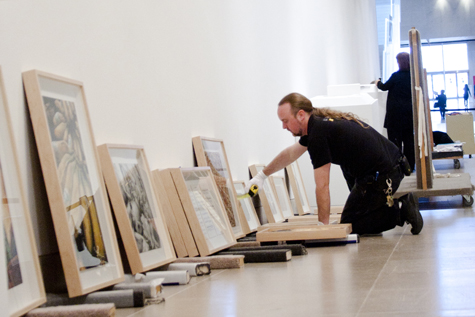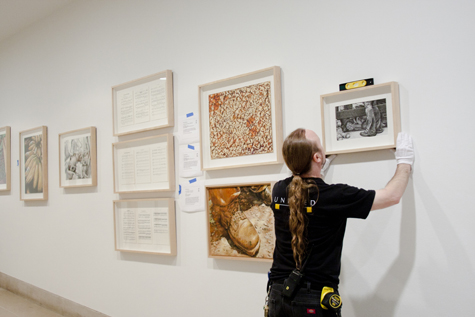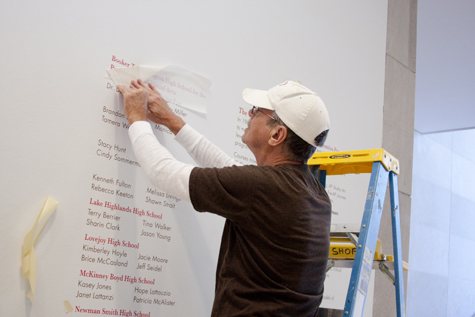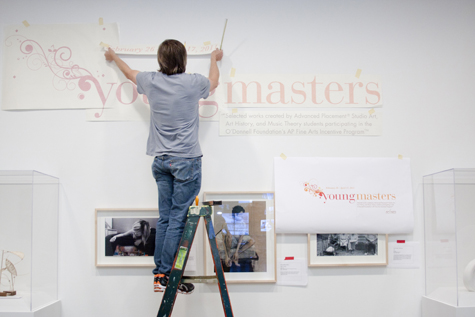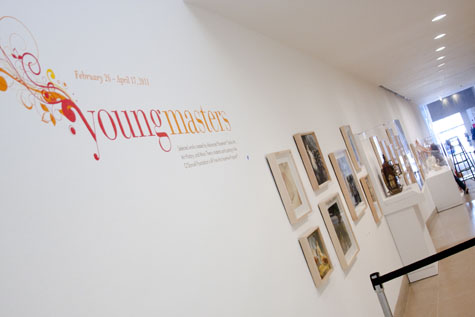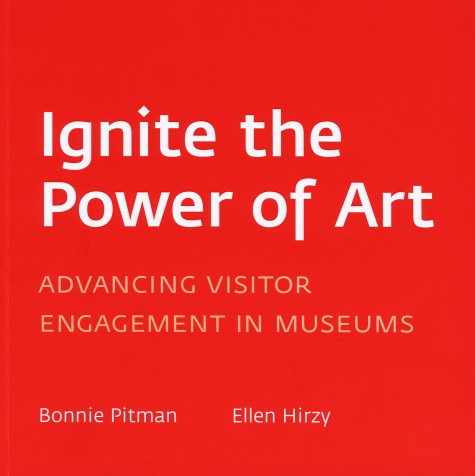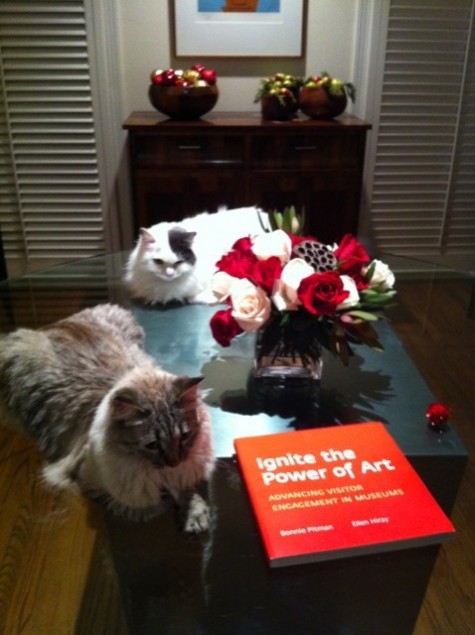With school back in full swing we thought we would showcase the students from Dallas ISD’s Skyline Architecture Cluster who created Sculpting Space: 299 Chairs. See the installation in person in the Center for Creative Connections on Level 1 through mid-November.

Archive for the 'Installation' Category
Seldom Scene: School Dais
Published August 29, 2011 Center for Creative Connections , Exhibitions , Installation ClosedTags: Center for Creative Connections, Dallas Independent School District, Dallas Museum of Art, Skyline Architecture Cluster
Seldom Scene’s Seldom Seen
Published June 8, 2011 Behind-the-Scenes , Collections , European Art , Installation 1 CommentTags: Collage, Dallas Museum of Art, Henri Matisse, Ivy in Flower
Rarely on view, Henri Matisse’s Ivy in Flower—a full-scale maquette for a stained glass window made late in the artist’s career—will be installed for six months in the Concourse. Here are some photos from the large cutout’s installation.
Henri Matisse, Ivy in Flower, 1953, colored paper, watercolor, pencil, and brown paper tape on paper mounted on canvas, Dallas Museum of Art, Foundation for the Arts Collection, gift of the Albert and Mary Lasker Foundation
Seldom Scene: Silence and Time
Published June 6, 2011 Behind-the-Scenes , Contemporary Art , Exhibitions , Installation 1 CommentTags: Dallas Museum of Art, Silence and Time
Below are photographs taken during the three-week installation of Silence and Time, which is on view through August 28.
[slideshow]
How to Install a 27-Foot Sculpture
Published May 26, 2011 Behind-the-Scenes , Contemporary Art , Curatorial , Exhibitions , Installation ClosedTags: Dallas Museum of Art, James Lee Byars, sculpture
The installation of James Lee Byars’s Figure of Death was caught on camera last week in preparation for the exhibition, Silence and Time, which opens this Sunday, May 29, in the Barrel Vault and Quadrant Galleries.
[youtube=http://www.youtube.com/watch?v=Fpu3fx3ZkZg]
James Lee Byars, The Figure of Death, 1986, basalt (ten pieces), Private Collection, Dallas, TX, © James Lee Byars
Video by Ted Forbes, Multimedia Producer at the Dallas Museum of Art
Papered Walls
Published May 18, 2011 Behind-the-Scenes , Collections , Curatorial , European Art , Exhibitions , Installation ClosedTags: Dallas Museum of Art, etching, Europe art, Landscape, lithography, Printmaking, woodcuts, Works on Paper
Sara Woodbury, McDermott Curatorial Intern for American and European Art, recently organized an installation of prints for the Works on Paper gallery on the Museum’s second floor. Cross Cultural Dialogues in European and American Landscapes features landscapes from the 19th and 20th centuries that demonstrate artistic influences occurring between Europe and America. The show also highlights different printmaking techniques. We’d like to explore a few of these methods here, and also share a behind-the-scenes look at how works on paper are stored and cared for at the Museum. All of the prints you’ll see here are included in the installation, so be sure to check them out in person next time you visit the DMA.
Printmaking Techniques
Artists use a variety of printing techniques, but we’ll highlight just three methods here: woodcuts, etching, and lithography.
Woodcuts are recognized by their linear quality, reflecting the laborious process required to make them. An artist draws onto a block of wood, and then all of the wood surrounding the drawing is carved away, turning the design into a three-dimensional relief. These raised lines are coated with ink, and the block is pressed to a piece of paper, printing the image. The oldest known printing method, the woodcut developed in Europe around 1400. It became less popular as easier printing techniques emerged, but many 20th-century artists embraced the medium’s bold, linear character.
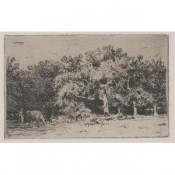
Charles Emile Jacque, A Corner of the Forest of Fontainbleau, n.d. (mid to late 19th-century), etching
Another interesting technique is etching, which is similar to drawing. To make an etching, an artist draws with a tool called an etching needle onto a metal plate that has been coated in wax. Next, the plate is submerged in an acid bath, which corrodes, or “bites” into the exposed metal lines, leaving the wax-covered areas unaffected. The plate is then rinsed, covered with ink, and wiped down. The ink remains in the grooves of the etched lines, and the plate is ready for printing. Etching first appeared in the 16th century and became especially popular during the 17th century. It also experienced a resurgence in popularity during the late 19th century, a period that has become known as the Etching Revival.
Lithography was invented in 1798 by Alois Senefelder and was initially used for commercial images. By the late 19th century, however, artists had begun exploring lithography’s creative possibilities. Lithography accommodates a wide range of styles, making it an ideal medium for the stylistic variety that characterizes 20th-century art.
Behind-the-Scenes with Registrar Anne Lenhart
Did you know that works on paper–including prints, drawings, photographs, and other types of work–are stored and cared for differently than paintings and sculptures? Works on paper are sensitive to various conditions and must be handled with special care and attention. We asked Anne Lenhart, Assistant Registrar, to share insight into how the Museum stores and handles its large collection of works on paper.
What DMA department is responsible for handling prints?
Anne: The care and handling of prints is a shared responsibility between the curators, registrars, conservators, and preparators. The curators are responsible for choosing the works on paper for installations and exhibitions. Once the works on paper are chosen, the registrars, conservators, and preparators are responsible for making sure the prints are in good condition and ready for installation.
Where are the prints stored in the Museum? How are they stored?
Anne: All of our objects are stored in secured art storage spaces. These areas, which have limited staff access and are monitored twenty-four hours a day, have a consistent temperature of 70° Fahrenheit (+/- 2°) and 50% (+/- 5%) relative humidity. Because paper is susceptible to even small changes in humidity (think about what happens to a sheet of paper when it contacts a drop of water), we try to be especially vigilant in terms of how we store our paper collection.
These numbers are considered guidelines for very stable pieces, such as those created with carbon-based ink applied to a good quality rag paper. Objects that are less stable—where the pigment and the materials are of lower or unknown quality or in the case of color photographs (especially Polaroids)—are exhibited for shorter periods of time.
How long can prints stay mounted in the galleries?
Anne: The general rule for exposure of works on paper is one to three months, and we try to keep the maximum period of time any work on paper is on view to less than six months. After a work comes down, we usually do not reinstall it for eighteen months so that it can “rest.”
Cross Cultural Dialogues in European and American Landscapes is on view now, and we hope to see you soon at the Museum.
Sara Woodbury is the McDermott Curatorial Intern for American and European Art, and Karen A. Colbert is the McDermott Education Intern for Teaching Programs.
Designing Stickley
Published April 20, 2011 Behind-the-Scenes , Decorative Art and Design , Exhibitions , Installation ClosedTags: Gustav Stickley, Gustav Stickley and the American Arts & Crafts Movement, The Craftsman
Hello, everyone! DMA resident exhibition designer Jessica Harden here to give you a short and sweet behind-the-scenes snapshot of where some of our inspiration for exhibition design comes from. The Gustav Stickley exhibition was fun to work on because I had lots of great resources, including original photographs and The Craftsman catalogues, which Stickley published with drawings of many of his architectural and interior designs and finishes . . .
as well as records of popular colors of the time. We chose paint colors for the exhibition based on the Sherwin-Williams Arts & Crafts palette. BTW, drawing up plans for the exhibition is also part of my job . . .
as is producing construction drawings.
But back to inspiration and resources—this is a photograph of a model dining room created to show Stickley’s furniture in 1903.
. . . and this is our gallery at the DMA that we designed and built to replicate the original.
In fact, if you look around the Gustav Stickley exhibition galleries, you might notice a number of details that were inspired by Stickley’s original designs. Here, we were inspired by how Stickley used interior cut-outs to define spaces and create interesting thresholds to transition from one room to the next.
We also took inspiration from Stickley’s use of simple trim work on walls to help us define spaces and create a more residential environment for the exhibition. This included using a cap rail to imply a lower ceiling height in our 14-foot-high exhibition galleries.
And just to have a little fun, we took a few chances to let visitors discover glimpses of upcoming galleries and objects along the way.
Even some of the smallest details of the exhibition were inspired by Stickley. Here you can see that the mount for this lamp was modeled after drawings from Stickley interiors and was fabricated by our extremely talented preparators and carpentry staff. They even made new heads for the screws to match the originals!
Gustav Stickley and the American Arts & Crafts Movement is on view at the Dallas Museum of Art until May 8, when it will travel to San Diego to open on June 18.
Jessica Harden is Exhibition Design Coordinator at the Dallas Museum of Art.
Seldom Scene: Readying the Show
Published April 18, 2011 American Art , Behind-the-Scenes , Curatorial , Installation ClosedLongtime Curator “Travels” DMA’s Silk Road
Published March 23, 2011 Asian Art , Behind-the-Scenes , Collections , Curatorial , Installation 3 CommentsTags: Ancient Art, Art History, Asian Art, Beginning of the World, Brancusi, Bust of a Man from Palmyra, China, Dallas Museum of Art, Highland Park High School, Japan, Javanese Ganesha, Shiva Nataraja, Silk Road
Following her new installation in the third-floor galleries of objects that reflect transport along Eurasia’s Silk Road, “seasoned” curator Dr. Anne Bromberg sat down with us to discuss her fascinating career. A lifelong Dallasite—except for her years at Harvard getting her B.A. in anthropology and M.A. and Ph.D. in classical art and archaeology—Dr. Bromberg has been on the staff of the Dallas Museum of Art for more than forty years, first as a lecturer and docent trainer beginning in 1962, then as head of the education department, and currently as The Cecil and Ida Green Curator of Ancient and Asian Art. What’s more, she has led an inspired life, traveling extensively to little-known locales, researching and experiencing the cultures within her discipline.
[slideshow]
Q: How would you describe your job at the DMA?
AB: Most curatorial jobs involve trying to acquire art for the museum, organizing exhibitions and/or working on exhibitions that come to us from elsewhere, publishing, lecturing, working with volunteers, [and] cultivating donors. In terms of legwork, it’s going around and seeing dealers and other collections, visiting other museums, going to conferences, and giving lectures outside the museum.
Q: You are in charge of a very diverse area of the Museum’s collections. What is your particular area of expertise?
AB: Classical art, meaning the art of ancient Egypt, Greece, and Rome, and all Asian art, but I’m mainly working with South Asian art.
Q: How did you become interested in Asian art?
AB: One of the really outstanding teachers I had taught evolution in her biology courses, including historical geology, and I was really fascinated with historical geology and that got me into reading about archaeology. And I thought, this is what I want to do. A good teacher makes a difference. I’ve actually been interested in Asia for a long, long time. When I was an undergraduate, I was reading books on Zen Buddhism and haiku, the Ramayana, and things like that. Books stimulate your passion to go see these things in reality.
Q: What are some of your favorite places you’ve traveled to?
AB: I think both my husband, Alan, and I would say the single favorite place we’ve been is Isfahan in Persia. Italy, of all the European countries, is easily the most seductive, and everybody I know who has been to India is dying to get back. We’ve been there so many times, and you feel like you’ve just scratched the surface.”
Q: What is your favorite object within the ancient and Asian collections at the DMA? Within another collection?
AB: The Shiva Nataraja, because that image is the single most important iconic image in Hinduism generally, and many Hindus would agree with that. It is exceptionally beautiful both aesthetically and because it represents the loving quality of the god Shiva. South Indian Hindu poems describe worship as falling in love with the god, and our Shiva Nataraja is the embodiment of that Chola period poetry.
Brancusi’s Beginning of the World. because of my background, I personally have a strong response to pure geometric forms and classical idealism, and I’m certainly not alone in believing that the ancient Greeks would appreciate that classical, pure, and geometric vision of the beginning of the world.
Q: Do you personally collect art? What types of objects are you most drawn to?
AB: Primarily we’ve collected what I would call third-world contemporary art—things that at the time were being made wherever—New Guinea, India, South America, Mexico, etc.
Q: Why do you think it is important for people to study non-Western art?
AB: If you study non-Western art, you’ll learn what human beings create and why. If you stick only to your own civilization, you are much less likely to think about why these things are being made . . . or about a much more serious question to me, why do we call it art?
Q: Describe your current project, an installation of objects from the DMA’s collections focusing on the Silk Road.
AB: The Silk Road installation is something that has interested me for a long time. We do have a lot of artwork that really displays the meaning of the Silk Road, which tied Eurasia together for millennia. So I was delighted when I got a space where I could show the ties between the Mediterranean world and Asia.
The Silk Road is an ancient transcontinental network of trade routes that spread across Eurasia from the Mediterranean to China and Japan. The phenomenon of the Silk Road is constantly studied and has recently been featured in museum exhibitions around the world. The new installation, organized by Dr. Bromberg, addresses six themes related to the Silk Road, including the development of cities and trade, the importance of animals to early societies, and the spread of religions. The installation presents well-known DMA favorites, such as the Javanese Ganesha and the bust of a man from Palmyra, and new works from several local private collections. Opening this weekend, come see the new installation on Level 3 the next time you visit the DMA.
Ashley Bruckbauer is the McDermott Intern for Programs and Resources for Teachers at the Dallas Museum of Art and Madelyn Strubelt is the McDermott Curatorial Intern of Ancient and Asian Art at the Dallas Museum of Art.
Seldom Scene: Installing Works by 2011’s Young Masters
Published March 7, 2011 Exhibitions , Installation 2 CommentsTags: Advanced Placement, Art History, Booker T. Washington High School for the Performing and Visual Arts, Coppell High School, Create Schools of Excellence in Fine Arts Education, Creekview High School, Dallas Museum of Art, Dallas-area high schools, Dr. Roberto Tejada, J. J. Pearce High School, L. V. Berkner High School, Lake Highlands High School, Lovejoy High School, McKinney Boyd High School, Music Theory, Newman Smith High School, O’Donnell Foundation’s AP Fine Arts Incentive Program, Plano East Senior High School, Plano Senior High School, Plano West Senior High School, Richardson High School, Studio Art, Young Masters
On Saturday we opened the Young Masters exhibition in our main Concourse. The exhibition features forty-eight selected works created by Advanced Placement® Studio Art, Art History, and Music Theory students from thirteen Dallas-area high schools participating in the AP Fine Arts Incentive Program. In a departure from the traditional studio art exhibition featuring original 2D and 3D works of art, this year the exhibition includes original essays written by AP Art History students in response to works in the DMA’s collections, as well as original four-minute compositions by AP Music Theory students. Here are a few images from last week’s installation:
Photography by Adam Gingrich, Dallas Museum of Art Marketing Assistant
The Night Owl and the Pussycats: Adventures in Igniting the Power of Art
Published February 23, 2011 Behind-the-Scenes , Center for Creative Connections , Collections , Education , Exhibitions , Installation , Late Nights , Social Media 3 CommentsTags: Bonnie Pitman, Dallas Museum of Art, Ellen Hirzy, Hydra, Ignite the Power of Art, Ignite the Power of Art: Advancing Visitor Engagement in Museums
From the very beginning in February 2009, this exciting book project inspired by the DMA’s director, Bonnie Pitman, was a collaborative effort. And my responsibility was to serve as the publication’s gatekeeper, charged with trafficking the manuscript, compiling and incorporating the numerous edits and comments, and keeping track of all the details and loose ends. There were “those days” when I imagined masses and masses of rapidly proliferating Hydra heads—and, like a metaphorical Hercules, the faster I lopped them off (i.e., completed a task), the faster they seemed to regenerate.
To keep track of all the edits to the digital manuscript, we used the Microsoft Word feature known as Track Changes, where, like a board game, everyone gets a different color. With five or six people making rainbow-colored edits, the manuscript became a vivid, almost psychedelic, dazzle of clashing colors, from bright pink to pale brown. Since large chunks of text were moved around, Word could only track this by keeping the old, lined-out passages on the page, so I found myself on “fast forward” through whole paragraphs on occasion. Then when comments were added to the screen, a running series of squashed balloons of text crowded in along the right-hand margin. Pretty soon we were laughing about eye strain.
Our quest for a perfect set of images became the next challenge. We pored through hundreds of DMA images—sorting, juxtaposing, weighing, and discarding—for each of the 141 photographs finally chosen. So it was definitely an exciting moment when the book went to the printer in early October 2010. As I write this blog two years later, we have distributed the printed copies. While this project “had its moments,” it’s also been enormously rewarding. I’ve learned a lot about data analysis, the design and packaging of information, and the challenges and pitfalls of fact checking. Even at moments of relatively frazzled morale, our spirits were always kept up by the knowledge that we were presenting something new and important. This book was a labor of love for a large group of people, especially for the two authors.
Ending on a light note, Bonnie kept us entertained throughout the editing and production process by sending digital pictures of her two cats, Leda and Perseus. Owing to the late hours she usually keeps, Bonnie was frequently hard at work on this book at one or two o’clock in the morning, seated at her glass work-table, with Leda and Perseus lying on—or playing with—stacks of galleys, photo contact sheets, charts, layouts, and reports—all of which offered the cats an ideal playground. I still have the early photographs showing them stretched out on a hoard of papers and folders. The later pictures depict their puzzlement as the glass tabletop finally resurfaced and the papers receded. And there’s a final shot of the cats sitting wistful, but perhaps also slightly triumphant, on a table cleared of everything but a vase of flowers and a single copy of the printed book. I’m sure Leda and Perseus look forward to a sequel.
Eric Zeidler is Publications Coordinator at the Dallas Museum of Art.









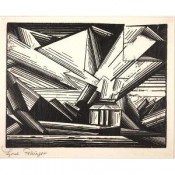
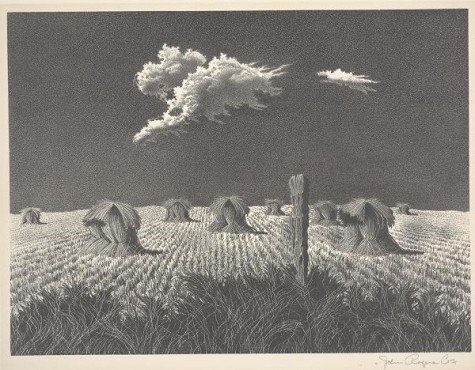
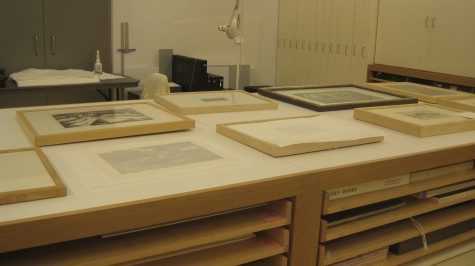
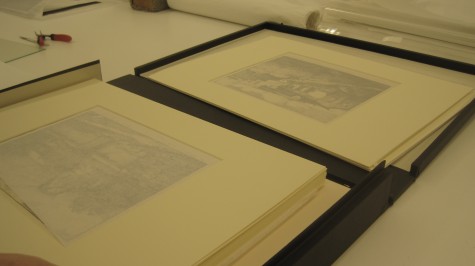
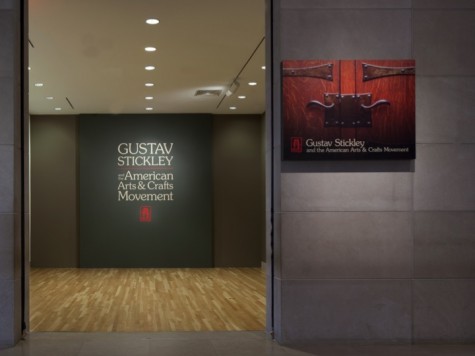
![image[1]](http://blog.dma.org/wp-content/uploads/2011/04/image1-e1303317774628.jpg)
![image[2]](http://blog.dma.org/wp-content/uploads/2011/04/image2-e1303317844580.jpg)
![image[3]](http://blog.dma.org/wp-content/uploads/2011/04/image3-e1303317895208.jpg)
![image[4]](http://blog.dma.org/wp-content/uploads/2011/04/image4-e1303317938366.jpg)
![image[5]](http://blog.dma.org/wp-content/uploads/2011/04/image5-e1303317994992.jpg)
![image[6]](http://blog.dma.org/wp-content/uploads/2011/04/image6-e1303318039225.jpg)
![image[7]](http://blog.dma.org/wp-content/uploads/2011/04/image7-e1303318080726.jpg)
![image[8]](http://blog.dma.org/wp-content/uploads/2011/04/image8-e1303318126745.jpg)





